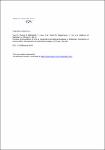N-linked glycosylation of SV2 is required for binding and uptake of botulinum neurotoxin A
Yao, Guorui
Zhang, Sicai
Mahrhold, Stefan
Lam, Kwok-ho
Stern, Daniel
Bagramyan, Karine
Perry, Kay
Kalkum, Markus
Rummel, Andreas
Dong, Min
Jin, Rongsheng
Botulinum neurotoxin serotype A1 (BoNT/A1), a licensed drug widely used for medical and cosmetic applications, exerts its action by invading motoneurons. Here we report a 2.0-Å-resolution crystal structure of the BoNT/A1 receptor-binding domain in complex with its neuronal receptor, glycosylated human SV2C. We found that the neuronal tropism of BoNT/A1 requires recognition of both the peptide moiety and an N-linked glycan on SV2. This N-glycan—which is conserved in all SV2 isoforms across vertebrates—is essential for BoNT/A1 binding to neurons and for its potent neurotoxicity. The glycan-binding interface on SV2 is targeted by a human BoNT/A1-neutralizing antibody currently licensed as an antibotulism drug. Our studies reveal a new paradigm of host-pathogen interactions, in which pathogens exploit conserved host post-translational modifications, thereby achieving highly specific receptor binding while also tolerating genetic changes across multiple isoforms of receptors.
No license information

